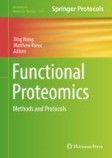Search
Search Results
-
Veillonellaceae family members uniquely alter the cervical metabolic microenvironment in a human three-dimensional epithelial model
Bacterial vaginosis (BV) is a gynecologic disorder characterized by a shift in cervicovaginal microbiota from Lactobacillus spp. dominance to a...

-
Development of a chimeric protein based on a proteomic approach for the serological diagnosis of human tegumentary leishmaniasis
Leishmania braziliensis is responsible for most cases of human tegumentary leishmaniasis (HTL) and has caused a wide range of clinical...

-
Advancements in Vibrio vaccines for aquaculture
Nowadays, the prevalence of infectious vibriosis soars due to the extensive development of marine fishery, resulting in substantial annual fish...

-
Sifting through the core-genome to identify putative cross-protective antigens against Riemerella anatipestifer
AbstractInfectious serositis of ducks, caused by Riemerella anatipestifer , is one of the main infectious diseases that harm commercial ducks....

-
Metatranscriptomics, Metaproteomics, and Metabolomics Approaches for Microbiome Characterization
Every living thing has its own unique microbiome. Environmental niches are sensitive to changes in the microbiome and how those changes affect them....
-
Double One-Dimensional Electrophoresis (D1-DE) Adapted for Immunoproteomics
The classical proteomics approach for the identification of allergen candidates consists on the separation of proteins by high-resolution...
-
Development of an immunogen containing CD4+/CD8+ T-cell epitopes for the prophylaxis of tegumentary leishmaniasis
AbstractTegumentary leishmaniasis (TL) is a disease of high severity and incidence in Brazil, and Leishmania braziliensis is its main etiological...

-
Two-Dimensional Electrophoresis Coupled with Western Blot as a Method to Detect Potential Neutralizing Antibody Targets from Gram-Negative Intracellular Bacteria
Antigen selection is a critical step in subunit vaccine design, especially if the goal is to identify antigens that can be bound by neutralizing...
-
Serological Proteome Analysis for the Characterization of Secreted Fungal Protein Antigens
Defining the humoral immune response to infectious agents is important for gaining insights into infectious diseases and the response of the immune...
-
A Proteomic Approach to Studying the Effects of Xenobiotics on Aquatic Living Organisms
Fish is a crucial source of nutritious food all over the world. Aquatic ecosystems are highly exposed to anthropogenic contaminants, leading to...
-
Production of recombinant proteins including the B-cell epitopes of autolysin A of Staphylococcus aureus isolated from clinical sheep mastitis and their potential for vaccine development
Staphylococcus aureus is the most common clinical mastitis-associated pathogen in sheep which contributes to reduced welfare of affected animals and,...

-
Systems Biology: A New Era for Vaccine Development; from Deductive Toward Inductive
Routine vaccination has always been a center of controversy due to its lack of acceptability among the masses. Adverse event (AE) study relating to...
-
Immunoproteomic analysis of Clostridium botulinum type B secretome for identification of immunogenic proteins against botulism
ObjectivesTo identify immunogenic proteins of C. botulinum type B secretome by immunoproteomic analysis.
ResultsIn the present study, an attempt was...

-
Antigenic and conserved peptides from diverse Helicobacter pylori antigens
Since the revolutionary finding of Helicobacter pylori as a common bacterial infection, that a high research effort for its eradication has been...

-
The role of proteomics in the age of immunotherapies
The antigenic landscape of the adaptive immune response is determined by the peptides presented by immune cells. In recent years, a number of...

-
Proteomics Principles and Clinical Applications
Proteomics refers to the study of the proteome and the set of proteins present in a cell or organism in health or disease; this comprises a wide...
-
Prediction of peptide mass spectral libraries with machine learning
The recent development of machine learning methods to identify peptides in complex mass spectrometric data constitutes a major breakthrough in...

-
Identification and evaluation of novel vaccine candidates against Shigella flexneri through reverse vaccinology approach
AbstractShigellosis is a significant type of diarrhea that causes 160,000 deaths annually in a global scale. The mortality occurs mainly in children...

-
A host choosy gill parasite (Dactylogyrus spp.) in fish: an insight into host-parasite interaction for develo** control strategies
Dactylogyrosis is caused by more than 900 reported species of Dactylogyrus (gill fluke), mostly in Cyprinoidei fish leading to low to severe...

-
Omics in Aquaculture
The omics is playing a major role in the modern aquaculture sector and its associated research works. The omics studies like genomics, proteomics,...
